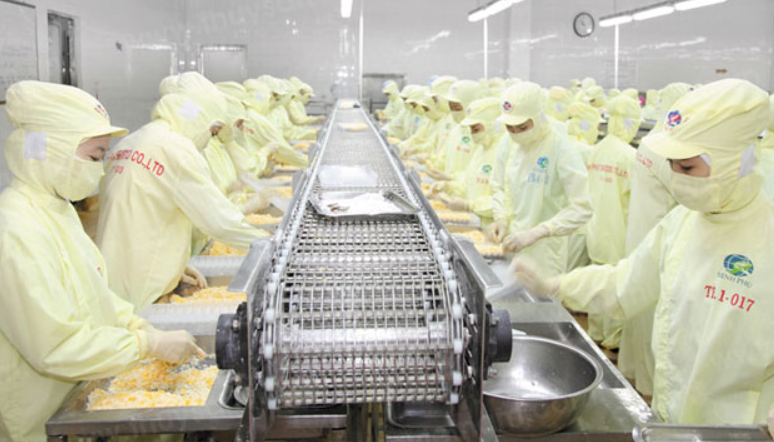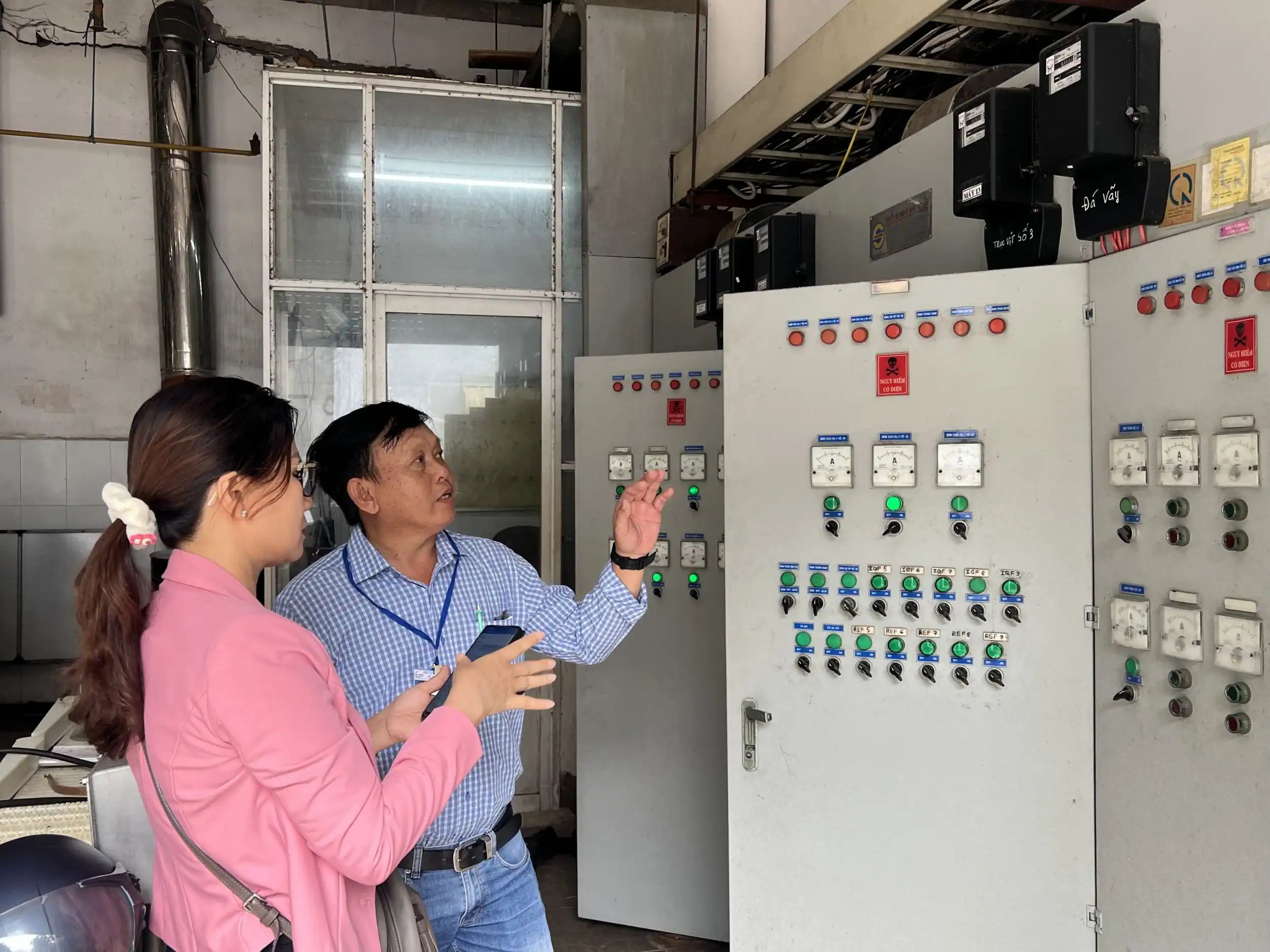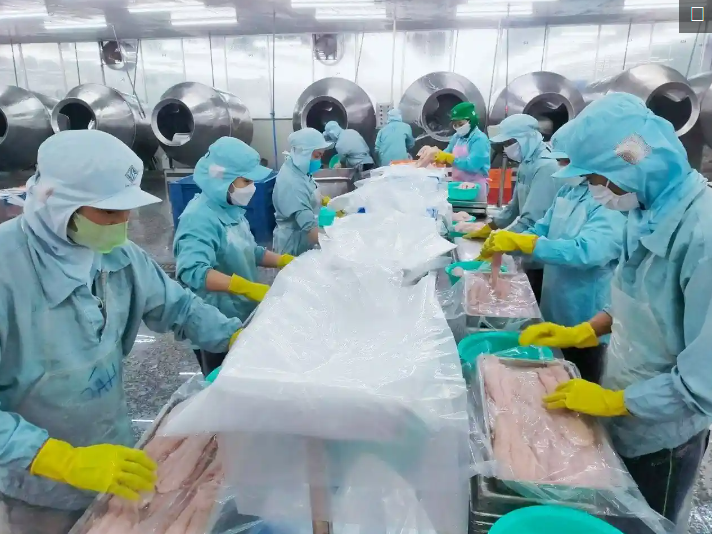Companies such as Minh Phu Seafood Corporation, Vietnam’s largest seafood exporter, have taken proactive steps to reduce energy consumption and save costs. Over 99% of Minh Phu's production is for export, and its success is partly due to the efficient use of energy and electricity. Minh Phu has replaced traditional fluorescent lighting with LED lighting in its processing plants, using energy-saving extreme-freezing equipment, using Biomass fuel...
Mr. Le Van Quang, Chairman and CEO of Minh Phu, explained that although the initial investment for 2,500 LED lights was higher (VND 2.8 billion compared to VND 1.2 billion for fluorescent lights), the savings are substantial. In one year, LED lights electricity cost is only 847 million dong, whereas fluorescent lights would cost 2.3 billion dong. This results in an annual saving of 1.458 billion dong (about 121 million dong per month).

Using LED lights helps save electricity effectively at Minh Phu factories.
In addition, the freezing system, which typically consumes the most energy, has been boldly upgraded by Minh Phu Group. To save energy, Minh Phu Group replaced the traditional IQF freezing system, which had a long freezing room that occupied a large area and wasted energy due to heat loss to the surrounding environment, with a high-speed IQF freezing system that shortens freezing time. Specifically, for the same product type (PTO shrimp size 16/20), the average freezing time previously took 14 minutes, but with the new equipment, it has been reduced to only 5 minutes. Additionally, the high-speed IQF system, combined with auxiliary LVS equipment and a pneumatic defrosting system, is designed and programmed to fully optimize the equipment's capacity, minimizing energy consumption.
"The benefits brought by the high-speed IQF freezing system, along with the LVS system and suitable programming, include a reduced freezing time to just 4.5 to 5 minutes, a product loss rate during freezing of less than 1%, a reduction in energy consumption by about 21-28%, and higher product quality due to the rapid freezing time under stable conditions," Mr. Quang excitedly shared.
According to experts, in the seafood processing industry, cooling systems for production and storage account for more than 70% of total energy consumption. If companies effectively implement simple energy-saving solutions during operations, they can save 10-15% of energy consumption without requiring significant investment costs.
Mr. Huynh Viet Chuong, Head of the Electromechanical Department at Caseamex, stated that saving electricity to reduce production costs is an urgent issue for businesses. Currently, Caseamex has installed new-generation LED lights to illuminate office buildings, factories, workshops, outdoor areas, and parking lots. Additionally, the company has installed energy monitoring meters on production lines and fitted inverters for high-power machinery.
Furthermore, Caseamex has adopted energy management standards, invested in modern production conveyors to increase production capacity while reducing energy consumption, and installed a rooftop solar power system with a capacity of up to 1MWp.
The Can Tho Seafood Import-Export Joint Stock Company (Caseamex) has invested in modern equipment to improve energy efficiency and save electricity.
Alongside technical solutions, Caseamex has also actively encouraged and motivated staff, workers, and employees to save electricity "at all times and in all places," such as turning off electrical devices when not in use. By implementing a wide range of solutions, Caseamex has managed to reduce its electricity costs by nearly 30% each month, achieving the goal of using renewable energy and increasing the competitive advantage of its exported seafood products.
The Southern Seafood Industry Co., Ltd. has also benefited significantly from energy savings. Recognizing the importance of efficient energy use, the company has implemented a wide range of solutions, from management to technical measures, to optimize production operations and reduce environmental impact.
Mr. Nguyen Phuoc Loc, Deputy Director of the company, stated that the average monthly electricity cost for production is nearly 2 billion VND. To increase energy efficiency, the company has invested in upgrading and installing modern machinery and inverters on production lines at the seafood processing plant, applying ISO quality management systems, and installing solar-powered water heating systems to provide hot water for cleaning product containers.
By implementing a variety of energy-saving measures, the company has been able to reduce monthly electricity consumption by 15%. More importantly, these efforts have increased production efficiency, met environmental protection criteria, and enhanced the competitiveness of the company's exported seafood products.
The export processing of pangasius at the Southern Seafood Industry Co., Ltd.
Facing intense market competition, saving production costs—especially by conserving energy through technological innovation and improving productivity and product quality—has become an essential strategy for seafood companies. This approach not only helps improve production efficiency but also boosts the competitiveness of these businesses in the global market amid economic integration.
Duc Do









.jpg?w=367&h=206&mode=crop)
.jpg?w=367&h=206&mode=crop)
 Promoting the Energy Efficiency Investment Market in the Industrial Sector
Promoting the Energy Efficiency Investment Market in the Industrial Sector
 Indonesia aims to reduce emissions through building industry
Indonesia aims to reduce emissions through building industry
 Energy Savings from Technical Solutions to Human Efforts
Energy Savings from Technical Solutions to Human Efforts
.jpg?w=367&h=206&mode=crop) 2024 Energy Efficiency Awards Launching Ceremony
2024 Energy Efficiency Awards Launching Ceremony
 Scaling Up Energy Efficiency Models in the Textile Industry
Scaling Up Energy Efficiency Models in the Textile Industry
 VSUEE Project Implementation Promotional Measures: Challenges and Opportunities
VSUEE Project Implementation Promotional Measures: Challenges and Opportunities
 Steel industry advised to optimise technology, save energy to promote export to EU
Steel industry advised to optimise technology, save energy to promote export to EU